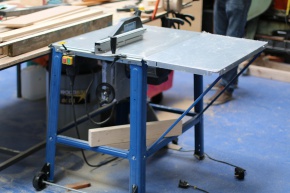Table Saw
![]() Warning! This page is out of date. This is the old table saw, the newer one is far more vicious, and eats 3 phases
Warning! This page is out of date. This is the old table saw, the newer one is far more vicious, and eats 3 phases
 | |
| Equipment Information | |
|---|---|
| Status | Unknown |
| Manufacturer | Scheppach |
| Model | HS120o |
| Hackspace Information | |
| Induction Required | No |
| Card RFID Enabled | No |
| Owner | Unknown |
A big noisy table saw which will make short work of large lumps of wood.
- 2.2kw
- 2800rpm
- 0-45 degree tilt
- 82mm max cut depth (49mm at 45 degrees)
Risk assessment for use of Table Saw.
Hazards.
- 1) Loss of fingers.
- 2) Loss of limb.
- 3) Exposure to high acoustic levels.
- 4) Inhalation of wood dust.
- 5) Hair or clothing entangled in blade.
- 6) Blade kick back causing projectile injury.
- 7) Damage to eyes from particles.
- 8) Injury from falling onto blade
Persons at risk.
- Operator.
- Persons nearby.
Initial assessment of risk.
| Hazard identified | Severity | Probability | Risk Factor |
| Loss of fingers. | 3 | 3 | 9 |
| Loss of limb | 4 | 2 | 8 |
| Exposure to high acoustic levels | 2 | 4 | 8 |
| Inhalation of wood dust | 2 | 3 | 6 |
| Hair or clothing entangled in blade | 3 | 3 | 9 |
| Blade kick back causing projectile injury | 3 | 3 | 3 |
| Damage to eyes from particles | 1 | 3 | 3 |
| Injury from falling onto blade | 4 | 3 | 12
|
Control measures.
- Users will be required to attend induction training to learn how to use the machine safely.
- Safety glasses will be worn.
- Blade guard will be used.
- Keep hands away from the saw blade.
- Wear ear defenders.
- Tie back long hair back and secure loose clothing. Ties or scarves must not be worn.
- Wear a dust mask.
Final assessment of risk
| Hazard identified | Severity | Probability | Risk Factor |
| Loss of fingers. | 3 | 1 | 9 |
| Loss of limb | 4 | 1 | 8 |
| Exposure to high acoustic levels | 2 | 2 | 8 |
| Inhalation of wood dust | 2 | 1 | 6 |
| Hair or clothing entangled in blade | 3 | 1 | 9 |
| Blade kick back causing projectile injury | 3 | 1 | 3 |
| Damage to eyes from particles | 3 | 1 | 3 |
| Injury from falling onto blade | 4 | 1 | 4
|
Points system
| Hazard severity | Points Rating | Definition |
| Nil | 1 | Very minor injury, bruise, graze, no risk of disease. |
| Slight | 2 | Minor injury, which would allow the individual to continue work after first aid treatment on site or at a local surgery. The duration of the stoppage or treatment is such that the normal flow of work is not seriously interrupted. |
| Moderate | 3 | Temporary disability causing injury or disease capable of keeping an individual off work for three days or more and reportable under RIDDOR |
| High | 4 | Causing death, serious injury or permanent disability to an individual. |
| Very high | 5 | Causing multiple deaths and widespread destruction eg. fire, building collapse. |
| Hazard likelihood | Points Rating | Definition |
| Remote possibility | 1 | There is really no risk present. Only under freak conditions could there be any possibility of an accident or illness. All reasonable precautions have been taken - This should be the normal state of the workplace. |
| Unlikely | 2 | This incident or illness might occur but the probability is low and the risk minimal. |
| Possible | 3 | The accident may occur if additional factors precipitate it, but it is unlikely to happen without them. |
| Highly likely | 4 | Will happen more often than not. Additional factors could precipitate an incident but it is still likely to happen without this additional factor. |
| Inevitable | 5 | If the work continues as it is, there is almost 100% certainty that an accident will happen, for example:
A broken stair or broken rung on a ladder Bare, exposed electrical conductors Unstable stacks of heavy boxes |
| Risk Rating Score | Definition | Action |
| 1 to 4 | Low | No action required |
| 5 to 9 | Moderate | Reduce risks if reasonably practicable |
| 10 to 15 | High Risk | Priority action to be undertaken |
| 16 to 25 | Unacceptable | Action must be taken IMMEDIATELY |